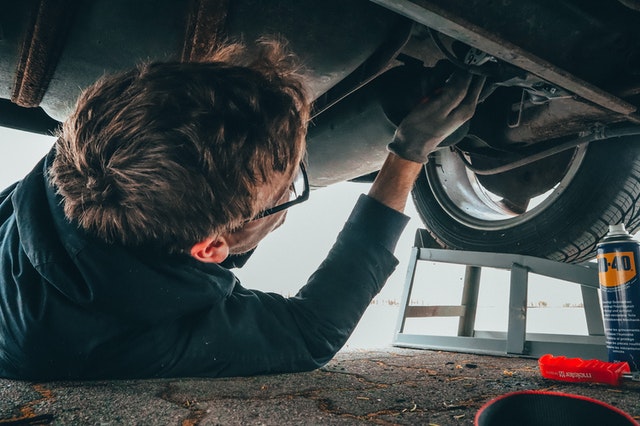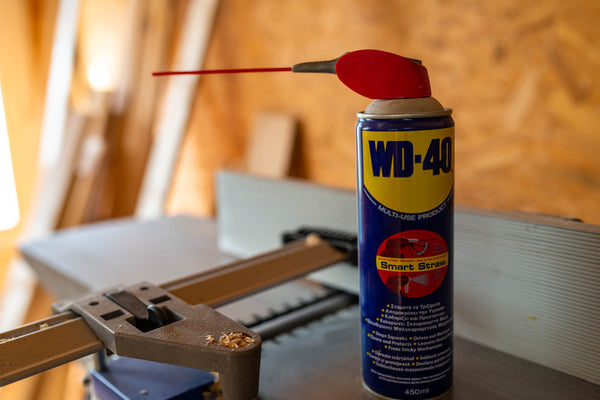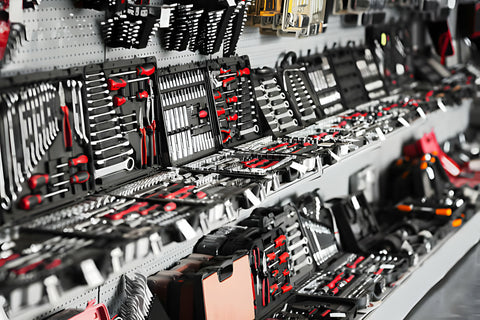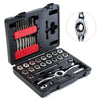
12 Basic Tools and Toolkits For Car Maintenance
Whether it's an old clunker of yours or a new flashy model, there are endless maintenance possibilities that could arise.
With the right tools and a little auto mechanics knowledge, you could do all your car maintenance yourself and save big by not having to go to car repair shops. Not only will these tools help you maintain your car, but they can also come in handy during emergencies.
Essential Car Maintenance Toolkit - What You Need to Keep Your Car Running Smoothly
Maintaining your car doesn't have to be a daunting task if you have the right tools at your disposal. A well-rounded toolkit is the key to efficiently tackling various maintenance tasks. Start with a comprehensive socket set that includes standard and metric sizes, along with different driver sizes. This versatile set ensures you can handle nuts and bolts of varying dimensions. Combine this with a plier set that covers a range of activities, including electrical work, and a combination wrench set for those hard-to-reach spaces.
Screwdrivers are indispensable for any car or bike maintenance, offering flexibility with different-sized heads for various screws. Zip ties come in handy for keeping cables organized during maintenance. A tire pressure gauge is crucial for ensuring optimal gas mileage and tire lifespan. Duct tape, with its versatility, can serve as a temporary fix for various issues, from bodywork damage to emergency hose repairs. Jumper cables are essential for overcoming a dead battery situation, ensuring you're never stranded.
In today's fast-paced world, ensuring your car runs smoothly is paramount, and the key lies in having the right tools. This article emphasizes the importance of a well-rounded toolkit for efficient car maintenance. From the essential comprehensive socket set and versatile plier set to the ever-handy screwdrivers, zip ties, and tire pressure gauge, each tool plays a crucial role. The inclusion of emergency essentials like duct tape and jumper cables ensures you're prepared for unexpected situations. Empower yourself with these tools, and you'll find that maintaining your car becomes a manageable and cost-effective endeavor, allowing you to tackle various issues with confidence.
A well-equipped toolkit is the foundation of successful car maintenance. From versatile socket sets to pliers, screwdrivers, and emergency essentials like duct tape and jumper cables, these tools empower you to address a range of issues efficiently.
Here are 12 of the most basic tools and toolkits for car maintenance.
1. Socket Sets

One of the most important tools for any auto mechanic is a good socket set. A standard socket set should include standard/SAE and metric sizes as well as 3/8 inch, 1/4", or even 1/2" drivers along with thin-walled sockets that are perfect when you need an extra delicate grip on tight jobs because they're so light!
2. Pliers and Wirecutters

Pliers and cutters are tools we find ourselves using quite frequently when working on a car. They are indispensable to a DIYer. You'll need these handy tools to work on and maintain electrical project within your car. To cover a broad range of maintenance activities get yourself a plier set that includes the diagonal wire cutter, slip-joint, needle-nose and groove or arc-joint pliers.
3. Combination Wrench Set

The socket set is a great start to any mechanic's toolkit, but sometimes you will need an additional wrench for the job. Sockets can't reach all nuts and bolts because they are in tight spaces. A combination wrench kit can come in handy when some nuts or bolts just won't fit into place without some extra heft behind it!
4. Screwdrivers

A screwdriver set is a must-have for anyone who does any sort of car and bike maintenance - you could even keep them around the house! Get an all-inclusive kit with different sized heads that give extra flexibility in fitting all types and sizes of screws and fasteners. The ratcheting driver handles make turning screws faster and easier.
5. Zip Ties

Zip ties are an essential part of any mechanic’s toolkit. They can be used to bundle cables and wires together during car maintenance, keep everything tidy while working on a vehicle. For added convenience buy lots of different sizes so you never run out when needed most.
6. Tire Pressure Gauge

Tire pressure is one of those things that you should check often, but it's easy to forget when life gets busy. If your tires are underinflated because they haven't been checked recently then this could lead to lower gas mileage as well as shorter lifespans for both tread wear. Analogue dial faced or digital gauges are best for accurate and reliable reading rather than the cheap stick-up types.
7. Duct tape

Duct tape is one of the most versatile tools in any car mechanic's toolkit. It can patch a myriad of ills from damaged bodywork after an accident to temporary emergency fixes on hoses and other parts, but it's also useful when you need it for something more than your vehicle--like fixing things around home or office!
8. Jumper Cables

Jumper cables are a much-needed tool for any car owner. A dead battery can be frustrating and deny you access to your vehicle, but with heavy-duty cables on-hand there is no need to worry about getting stranded and making it back home or to the nearest garage! Make sure the cables are thick with strong spring clamps on the ends.
9. Mechanics Tool Set

If you own a car, then you must stock up on mechanic tools. And rather than buying items individually, you can purchase complete sets containing the most popularly used tools. A basic toolset will make sure you are always prepared with sockets, ratchet handles, wrenches, pliers and extensions that can be used on any essential job.
10. Lubricants and Penetrating Oil

You need to clean and lubricate moving parts of your car, so you'll need a few liquid sprays. A rust penetrant can help you remove stubborn bolts and prevent future accumulation of rust. Brake cleaner is quick to use, making it perfect for cleaning any metal parts including brakes. Silicone lubricant eliminates squeaking while keeping friction at bay thanks to its ability not to attract dirt.
11. Breaker Bar

To remove the really stubborn lug nuts on the wheels, then a breaker bar is called for. If you have one of those stuck bolts that just won't let go despite your best efforts to break them loose using a normal ratcheting wrench (which could damage it), then the breaker bar with its extended length will give you extra leverage to loosen them
12. Latex Gloves

DIY car maintenance is a messy endeavour, and making your vehicles exterior and interior stays clean and stain-free during repairs should be in mind. Latex gloves offer a great way to keep your hands clean while working on projects. They're also disposable, which means you don't need to worry about touching greasy or dirty materials with them - just throw them away after each use.
Car Care 101: Car Maintenance Tips and Kits for DIY
To embark on successful DIY car maintenance, understanding the fundamental tools and their applications is crucial. A combination of socket sets, pliers, and wrenches allows you to tackle diverse issues. A screwdriver set offers flexibility for different screws, while zip ties maintain organization during tasks. Regularly checking tire pressure with a gauge is a simple yet effective way to enhance gas mileage and tire longevity. Duct tape proves invaluable for quick fixes, and jumper cables ensure you're never stranded with a dead battery.
In the realm of DIY car maintenance, this article serves as a comprehensive guide to empower enthusiasts with essential tips and toolkits. It underscores the significance of understanding fundamental tools and their applications in ensuring successful do-it-yourself car care. The combination of socket sets, pliers, and wrenches provides a versatile arsenal for addressing diverse issues efficiently. A well-curated screwdriver set offers flexibility, while zip ties contribute to task organization. Emphasizing the importance of regular tire pressure checks using a gauge, the article highlights the positive impact on gas mileage and tire lifespan. Additionally, the inclusion of duct tape for quick fixes and jumper cables for addressing battery-related challenges ensures a well-rounded toolkit. Armed with this knowledge, readers are equipped to make DIY car maintenance a seamless and routine part of their automotive care, fostering a sense of confidence in handling various tasks with precision and ease.
Equipping yourself with these fundamental tools and understanding their uses forms the basis of effective DIY car maintenance. Regular checks and quick fixes become second nature with the right toolkit.
Best Maintenance Tool Kits for DIY Car Care - Reviews and Recommendations
For a hassle-free DIY car care experience, investing in a quality maintenance tool kit is a wise decision. Opt for a mechanic's tool set that includes popularly used items like sockets, ratchet handles, wrenches, pliers, and extensions. A breaker bar becomes essential for stubborn lug nuts, providing extra leverage. Include lubricants and penetrating oil in your toolkit to clean and lubricate moving parts, ensuring optimal performance.

Navigating the realm of DIY car care becomes a seamless endeavor with this insightful article on the best maintenance tool kits. Recognizing the pivotal role of a quality toolkit, it advises readers to invest wisely for a hassle-free experience. The recommendation leans towards a mechanic's tool set, a comprehensive ensemble featuring sockets, ratchet handles, wrenches, pliers, and extensions – all indispensable for a range of tasks. Highlighting the significance of a breaker bar for stubborn lug nuts, the article emphasizes the extra leverage it provides. Inclusion of lubricants and penetrating oil further elevates the toolkit, ensuring the cleanliness and lubrication of moving parts for optimal performance. With this expert guidance, readers are poised to make informed decisions, selecting tool kits that not only simplify DIY car care but also equip them to handle a diverse array of automotive tasks effectively.
Choosing the right maintenance tool kit simplifies DIY car care. A mechanic's set, complemented by a breaker bar and lubricants, ensures you're well-prepared for a variety of tasks.
Tips for Car Owners: Step-by-step guide for advanced car maintenance
As your confidence in DIY car maintenance grows, you may want to tackle more advanced tasks. Ensure you have a comprehensive toolkit with the basics, along with additional items like a breaker bar for stubborn lug nuts. Lubricants and penetrating oil become essential for cleaning and maintaining various components. Latex gloves keep your hands clean during messy repairs, allowing for a more comfortable experience.
This article provides valuable insights for car owners looking to advance their DIY car maintenance skills. As individuals gain confidence in tackling more complex tasks, the guide emphasizes the importance of a comprehensive toolkit. Beyond the basics, the inclusion of a breaker bar for stubborn lug nuts is highlighted, offering additional leverage for intricate jobs. The significance of lubricants and penetrating oil is underscored, crucial for the thorough cleaning and maintenance of various components, contributing to prolonged vehicle longevity. A noteworthy addition is the recommendation of latex gloves, ensuring a clean and comfortable experience during messy repairs. The article culminates with a reminder that progressing to advanced car maintenance demands a well-rounded toolkit, enabling car owners to confidently undertake challenging tasks and, in turn, save money on repairs by harnessing the right tools and taking necessary precautions.
Gradually progressing to advanced car maintenance requires a well-rounded toolkit. With the right tools and precautions like latex gloves, you can confidently take on more challenging tasks, saving money on repairs.
Beyond the Tool Box: Essential Skills Every DIY Car Enthusiast Should Know
Understanding the dynamics of a vehicle, from its mechanical to its electronic systems, requires a blend of analytical thinking, practical problem-solving, and a keen attention to detail. These are the skills that enable DIY enthusiasts to diagnose issues accurately, perform repairs efficiently, and ultimately, keep their vehicles running smoothly. Moreover, these skills empower individuals to tackle a wide range of automotive problems, reducing reliance on professional mechanics for minor fixes and maintenance tasks. Let's delve into the specific skills that every DIY car enthusiast should aim to master, ensuring they're well-equipped to handle the complexities of modern automotive care.
Understanding Vehicle Mechanics
-
Grasping the Basics: A solid understanding of your vehicle's fundamental mechanical systems (engine, transmission, braking system) is crucial. Start by studying your car's manual, then gradually explore each component's function and how they interconnect.
-
Learning from Problems: When faced with a malfunction or a performance issue, take it as a learning opportunity. Research the symptoms, understand the underlying mechanics, and apply this knowledge in troubleshooting.
-
Hands-on Practice: There's no substitute for hands-on experience. Regularly undertake simple maintenance tasks (oil changes, tire rotations) to build familiarity with your vehicle's anatomy and operation.
Developing Diagnostic Skills
-
Using Diagnostic Tools: Learn to use basic diagnostic tools like OBD-II scanners. These can provide valuable insights into the health of your vehicle and help pinpoint issues without guesswork.
-
Interpreting Symptoms: Develop the skill to interpret signs of trouble (unusual noises, vibrations, warning lights) by correlating them with potential mechanical or electrical issues.
-
Consulting Resources: Make use of online forums, automotive repair manuals, and tutorials. These resources can offer guidance and second opinions when diagnosing complex issues.
Enhancing Problem-Solving Abilities
-
Creative Thinking: Sometimes, automotive issues require unconventional solutions. Cultivate the ability to think outside the box, especially when dealing with older models or rare problems.
-
Resource Management: Learn to assess whether a repair is within your skillset or if it necessitates professional intervention. This includes evaluating the cost-effectiveness of DIY repairs versus shop rates.
-
Patience and Perseverance: Some repairs might not go as planned on the first try. Develop the patience to re-assess and the perseverance to attempt different solutions until the issue is resolved.
A Beginner's Guide to Diagnosing and Fixing Issues
Diagnosing and fixing car issues on your own can be a daunting task for beginners. Yet, it's a skill that can save you time, money, and the inconvenience of being without your vehicle. The key to successfully diagnosing and repairing automotive problems lies in adopting a methodical approach, bolstered by a willingness to learn and adapt. This involves familiarizing yourself with your car's systems, understanding common problems that may arise, and developing a structured problem-solving strategy. By breaking down the diagnostic and repair process into manageable steps, even novices can begin to navigate the complexities of car maintenance with confidence.
Building Foundational Knowledge
-
Familiarize with Your Car: Spend time understanding your vehicle's specific make and model. This includes reading the owner's manual, studying the layout of the engine bay, and knowing the functions of various components.
-
Learn Common Issues: Research common problems associated with your vehicle type. Knowing these can help you quickly identify symptoms and their probable causes.
-
Understand Basic Systems: Gain a basic understanding of key automotive systems (electrical, fuel, cooling, etc.) and how they work together. This foundational knowledge is crucial for effective troubleshooting.
Structuring the Diagnostic Process
-
Observation: Start by carefully observing the symptoms. Note any sounds, smells, visual cues, or performance issues.
-
Research and Analysis: Use reliable sources to research the observed symptoms. Automotive forums, repair manuals, and tutorials can offer valuable insights.
-
Use of Diagnostic Tools: Familiarize yourself with simple diagnostic tools, such as a multimeter and an OBD-II scanner. These tools can provide concrete data to aid your diagnosis.
Hands-on Repair Strategies
-
Start Small: Begin with simpler tasks (replacing filters, fluids, etc.) to build confidence. Gradually progress to more complex repairs as your skills develop.
-
Follow Step-by-Step Guides: Utilize detailed repair manuals or online tutorials. These can guide you through the repair process, reducing the risk of mistakes.
-
Safety First: Always prioritize safety. Use proper equipment (gloves, goggles), ensure the car is securely lifted (if necessary), and disconnect the battery before performing electrical work.
Tech Savvy Mechanic: Using Apps and Gadgets to Enhance Your Car Care Routine
In today's digitally driven world, technology plays a pivotal role in enhancing the efficiency and effectiveness of car maintenance routines. For the tech-savvy mechanic, leveraging the power of apps and gadgets is not just about embracing modernity; it's about harnessing a suite of tools that can simplify diagnostics, streamline maintenance tasks, and provide invaluable insights into the health and performance of their vehicle. From OBD-II scanners that interface with smartphones to apps that remind you of scheduled maintenance, technology offers a plethora of resources designed to make automotive care more accessible and manageable.
OBD-II Scanners and Apps
-
Smartphone-Compatible Scanners: Invest in an OBD-II scanner that connects to your smartphone via Bluetooth. These devices, combined with the right app, can read diagnostic trouble codes (DTCs), monitor real-time data, and even suggest potential fixes.
-
App Features: Look for apps that offer comprehensive features, including code definitions, live data streams, and maintenance reminders. Some apps also allow you to track repair histories and share data with mechanics.
-
Choosing the Right Tool: Research and select a scanner and app combination that suits your needs and budget. Consider factors such as compatibility with your vehicle, ease of use, and the depth of diagnostic information provided.
Maintenance and Fuel Tracking Apps
-
Scheduled Maintenance Reminders: Use apps that can track your vehicle's maintenance schedule, reminding you of upcoming service intervals based on mileage or time.
-
Fuel Efficiency Tracking: Some apps allow you to log fuel purchases and calculate your vehicle's fuel efficiency over time, helping you identify any deviations that might indicate a problem.
-
Document Storage: Opt for apps that enable you to store important documents (insurance, registration, service records) digitally, ensuring they're readily accessible when needed.
Importance of Preventative Car Maintenance
Embracing preventative maintenance requires a commitment to regular check-ups and an understanding of your vehicle's specific maintenance needs. This involves more than just oil changes and tire rotations; it encompasses a comprehensive range of services designed to keep all systems functioning optimally. In this section, we'll dissect the importance of preventative maintenance beyond the basics, highlighting how it contributes to vehicle longevity, safety, and overall performance.
Enhanced Safety
One of the most significant benefits of preventative maintenance is the assurance of safety. Regular inspections and maintenance tasks such as brake checks, tire pressure adjustments, and fluid level assessments ensure that critical safety systems are always in top condition. This not only protects you and your passengers but also others on the road. Neglecting these aspects can lead to dangerous situations, such as brake failure or tire blowouts, which are preventable with routine care.
Cost Savings
While preventative maintenance requires an upfront investment, it can lead to substantial cost savings over time. Addressing minor issues before they escalate into serious problems can save you from expensive repairs. For example, replacing worn brake pads on time is far less costly than repairing damaged brake rotors due to neglected maintenance. Additionally, maintaining optimal vehicle efficiency through regular servicing can improve fuel economy, further reducing operating costs.
Environmental Benefits
A well-maintained vehicle is also better for the environment. Regular servicing ensures that your car runs efficiently, which can lead to lower emissions. Addressing issues like leaking fluids or a malfunctioning exhaust system not only prevents environmental contamination but also ensures your vehicle meets emission standards.
Conclusion
Gather these essential tools to save money on car repairs and feel confident fixing your vehicle by yourself. You can do simple maintenance tasks like changing a blown fuse or a burnt low beam light bulb, while some repairs should be left to the professionals. As you gain more experience more challenging fixes like replacing brake pads, filters and spark plugs will become easier.
Related Article: Different Types of DIY Rachets and Sockets



